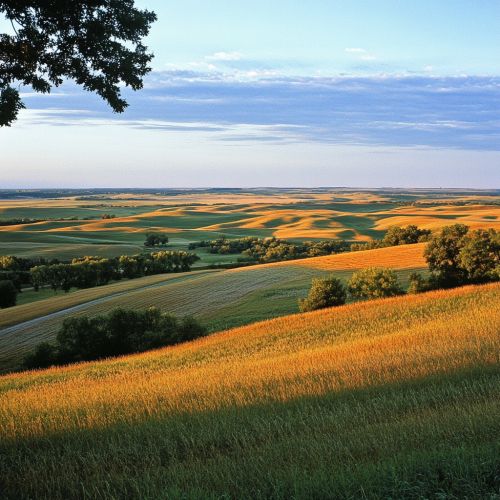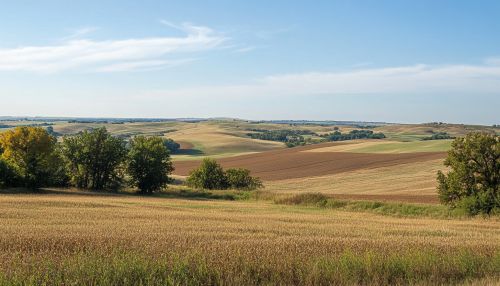Johnson County, Kansas: Difference between revisions
(Created page with "== Geography and Climate == Johnson County, Kansas, located in the northeastern part of the state, is part of the Kansas City metropolitan area. The county covers an area of approximately 480 square miles (1,243 km²). It is bordered by Wyandotte County to the north, Miami County to the south, Douglas County to the west, and the state of Missouri to the east. The county's topography is characterized by gently rolling plains, with the Kansas River forming its northern bo...") |
No edit summary |
||
| Line 4: | Line 4: | ||
The county's topography is characterized by gently rolling plains, with the Kansas River forming its northern boundary. The climate in Johnson County is classified as humid continental, with hot, humid summers and cold, dry winters. Average annual precipitation is around 40 inches (1,016 mm), with the majority falling during the spring and summer months. | The county's topography is characterized by gently rolling plains, with the Kansas River forming its northern boundary. The climate in Johnson County is classified as humid continental, with hot, humid summers and cold, dry winters. Average annual precipitation is around 40 inches (1,016 mm), with the majority falling during the spring and summer months. | ||
[[Image:Detail-97875.jpg|thumb|center|Rolling plains and agricultural fields in Johnson County, Kansas.|class=only_on_mobile]] | |||
[[Image:Detail-97876.jpg|thumb|center|Rolling plains and agricultural fields in Johnson County, Kansas.|class=only_on_desktop]] | |||
== History == | == History == | ||
Latest revision as of 13:21, 4 September 2024
Geography and Climate
Johnson County, Kansas, located in the northeastern part of the state, is part of the Kansas City metropolitan area. The county covers an area of approximately 480 square miles (1,243 km²). It is bordered by Wyandotte County to the north, Miami County to the south, Douglas County to the west, and the state of Missouri to the east.
The county's topography is characterized by gently rolling plains, with the Kansas River forming its northern boundary. The climate in Johnson County is classified as humid continental, with hot, humid summers and cold, dry winters. Average annual precipitation is around 40 inches (1,016 mm), with the majority falling during the spring and summer months.


History
Johnson County was established on August 25, 1855, as one of the original 33 counties created by the Kansas Territory legislature. The county was named after Reverend Thomas Johnson, a Methodist missionary and founder of the Shawnee Methodist Mission. The mission played a significant role in the early settlement and development of the area.
During the mid-19th century, Johnson County was a key location along the Santa Fe Trail, a major trade route connecting Missouri to Santa Fe, New Mexico. The county's strategic position contributed to its growth and development, attracting settlers and businesses.
The county experienced significant growth in the post-World War II era, driven by suburbanization and the expansion of the Kansas City metropolitan area. This period saw the development of numerous residential communities, commercial centers, and infrastructure projects.
Demographics
As of the 2020 United States Census, Johnson County had a population of approximately 609,863, making it the most populous county in Kansas. The county's population density is around 1,270 people per square mile (490/km²).
The racial and ethnic composition of Johnson County is predominantly White (non-Hispanic), accounting for about 80% of the population. Other significant demographic groups include African Americans, Asians, Hispanics, and Native Americans. The county is known for its relatively high median household income and educational attainment levels, with a significant proportion of residents holding bachelor's degrees or higher.
Economy
Johnson County boasts a diverse and robust economy, driven by various sectors including healthcare, education, finance, technology, and retail. The county is home to several major employers, such as Sprint, Garmin, and Black & Veatch, which contribute significantly to the local economy.
The healthcare sector is particularly prominent, with institutions like the University of Kansas Health System and Overland Park Regional Medical Center providing extensive medical services and employment opportunities. The county's education sector is also a major economic driver, with institutions like Johnson County Community College and the University of Kansas Edwards Campus offering a range of academic programs and contributing to workforce development.
Education
Johnson County is served by several public school districts, including Shawnee Mission, Blue Valley, and Olathe, which are known for their high academic standards and comprehensive educational programs. The county also has a number of private and parochial schools, offering diverse educational options for residents.
Higher education institutions in the county include Johnson County Community College (JCCC), one of the largest community colleges in the state, and the University of Kansas Edwards Campus, which offers a range of undergraduate and graduate programs. These institutions play a crucial role in providing accessible education and fostering economic development in the region.
Transportation
Johnson County has a well-developed transportation infrastructure, with several major highways and interstates facilitating regional connectivity. Interstate 35 (I-35) and Interstate 435 (I-435) are key routes that traverse the county, providing access to the broader Kansas City metropolitan area and beyond.
Public transportation in the county is primarily managed by Johnson County Transit, which operates a network of bus routes connecting various communities and employment centers. Additionally, the Kansas City Area Transportation Authority (KCATA) provides regional transit services, enhancing mobility for residents and visitors.
Government and Politics
Johnson County operates under a commission-manager form of government, with a seven-member Board of County Commissioners responsible for legislative functions and policy-making. The county manager oversees the day-to-day administration and implementation of policies.
Politically, Johnson County has historically leaned conservative, with the Republican Party dominating local elections. However, recent years have seen a shift towards more competitive races, with increasing support for Democratic candidates in certain areas.
Culture and Recreation
Johnson County offers a vibrant cultural scene, with numerous museums, theaters, and art galleries. The Johnson County Museum, located in Overland Park, provides insights into the county's history and heritage. The Nerman Museum of Contemporary Art, situated on the JCCC campus, showcases a diverse collection of contemporary artworks.
The county is also home to several parks and recreational facilities, including Shawnee Mission Park, one of the largest parks in the region. The park features a wide range of outdoor activities, such as hiking, fishing, and boating, making it a popular destination for residents and visitors alike.
Notable Communities
Johnson County encompasses several cities and towns, each with its own unique character and amenities. Some of the notable communities include:
- Overland Park: The largest city in Johnson County, known for its thriving business environment, excellent schools, and numerous recreational opportunities.
- Olathe: The county seat, offering a blend of suburban living and historical attractions, including the Mahaffie Stagecoach Stop and Farm.
- Shawnee: A city with a rich history and a strong sense of community, featuring a variety of parks and cultural events.
- Leawood: An affluent suburb known for its upscale shopping centers, dining options, and well-maintained neighborhoods.
See Also
- Santa Fe Trail
- Kansas City metropolitan area
- Shawnee Mission
- University of Kansas Health System
- Nerman Museum of Contemporary Art
